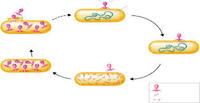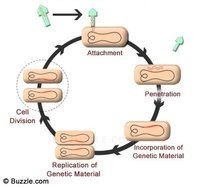
AP Bio - Viral Genome
Quiz
•
Science
•
11th Grade
•
Easy
Kristina Donaldson
Used 11+ times
FREE Resource
Enhance your content
20 questions
Show all answers
1.
MULTIPLE CHOICE QUESTION
1 min • 1 pt
Which viral cycle takes the longest to show symptoms?
Lysogenic
Lytic
2.
MULTIPLE CHOICE QUESTION
1 min • 1 pt
What is the first step to both cycles?
The virus attaches to a host
the virus injects genetic material
the host gets sick
the cell is destroyed
3.
MULTIPLE CHOICE QUESTION
1 min • 1 pt
When the viral DNA becomes active in the lysogenic cycle, which life cycle does it enter?
lytic
lysogenic
cell cycle
DNA replication
4.
MULTIPLE CHOICE QUESTION
30 sec • 1 pt

5.
MULTIPLE CHOICE QUESTION
30 sec • 1 pt

6.
MULTIPLE CHOICE QUESTION
30 sec • 1 pt
7.
MULTIPLE CHOICE QUESTION
30 sec • 1 pt
Viruses contain genetic material which carries the instructions for the construction of new virus particles. This genetic material is primarily composed of-
phospholipids
polysaccharides
nucleic acids
polypeptides
Create a free account and access millions of resources
Create resources
Host any resource
Get auto-graded reports

Continue with Google

Continue with Email

Continue with Classlink

Continue with Clever
or continue with

Microsoft
%20(1).png)
Apple
Others
By signing up, you agree to our Terms of Service & Privacy Policy
Already have an account?
Similar Resources on Wayground

19 questions
Cycles: Carbon, Nitrogen, Phosphorus
Quiz
•
9th - 12th Grade

15 questions
Organisms Interactions in Ecosystems
Quiz
•
7th Grade - University

15 questions
Relationship in the Ecosystem
Quiz
•
8th Grade - University

15 questions
Pathogens
Quiz
•
8th Grade - University

15 questions
Biology Final Exam Review
Quiz
•
9th Grade - University

15 questions
Nitrogen Cycle
Quiz
•
9th Grade - University

15 questions
Reporting Category Five Biology
Quiz
•
9th Grade - University

15 questions
Earth Day Lesson
Quiz
•
6th Grade - University
Popular Resources on Wayground

20 questions
Brand Labels
Quiz
•
5th - 12th Grade

10 questions
Ice Breaker Trivia: Food from Around the World
Quiz
•
3rd - 12th Grade

25 questions
Multiplication Facts
Quiz
•
5th Grade

20 questions
ELA Advisory Review
Quiz
•
7th Grade

15 questions
Subtracting Integers
Quiz
•
7th Grade

22 questions
Adding Integers
Quiz
•
6th Grade

10 questions
Multiplication and Division Unknowns
Quiz
•
3rd Grade

10 questions
Exploring Digital Citizenship Essentials
Interactive video
•
6th - 10th Grade
Discover more resources for Science

16 questions
Metric Conversions
Quiz
•
11th Grade

13 questions
Amoeba Sisters: Biomolecules
Interactive video
•
9th - 12th Grade

50 questions
Weathering, Erosion, and Deposition Review
Quiz
•
11th Grade

45 questions
Interim Review
Quiz
•
9th - 12th Grade

66 questions
Earth Sci Unit 2 Ch. 4-5 Test Review
Quiz
•
9th - 12th Grade

58 questions
Biomolecule Test Corrections
Quiz
•
9th - 12th Grade

20 questions
Trophic Levels and Food Webs
Quiz
•
10th - 12th Grade

10 questions
Identify Methods of Heat Transfer
Quiz
•
9th - 12th Grade
